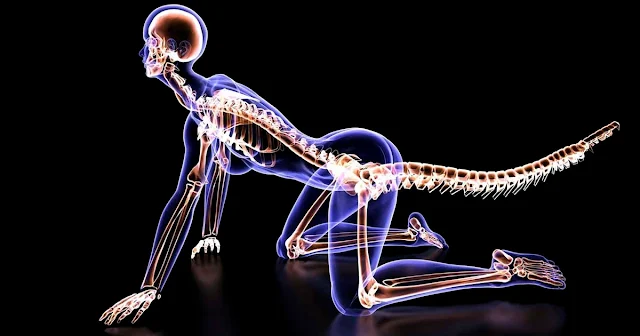One of the most remarkable changes in human evolution is the loss of our tails, a transformation that occurred around 25 million years ago. This pivotal shift not only altered the trajectory of our species but also marked a significant moment in the evolutionary history of primates. While scientists have long speculated on why humans lost their tails, the genetic cause has remained elusive—until now. A recent study published in Nature has finally uncovered the genetic factors responsible for this evolutionary change.

The Quest to Understand Tail Loss
The journey to unravel the mystery of human tail loss began in an unexpected way. Bo Xia, a graduate student at New York University, was inspired to investigate the origins of the human tailbone after injuring his own coccyx. This personal curiosity led Xia and his team to embark on a groundbreaking scientific investigation.
Through careful research, the team focused on the TBXT gene, which plays a crucial role in regulating tail length in various species. Their research revealed a unique genetic mutation within this gene, providing a major breakthrough in understanding human evolution.
The Role of Jumping Genes
A key aspect of this discovery lies in the role of Alu elements, often called “jumping genes.” These genetic elements, specific to primates, can move within the genome and cause significant changes. The researchers found that Alu elements inserted themselves into the TBXT gene, triggering a chain reaction that led to the loss of our tails.
This insertion activated a process known as alternative splicing, where RNA molecules are cut and restructured, which ultimately led to the deletion of a crucial exon. This change altered the structure and function of the resulting protein, leading to the tail loss seen in humans.
Validation Through Mice Studies
To confirm their findings, the researchers engineered laboratory mice with the same genetic mutations found in humans and apes. These genetically altered mice lost their tails, providing compelling evidence that the identified mutation plays a crucial role in the absence of tails in humans and other primates.
However, the study also uncovered a downside to tail loss: an increased risk of neural tube defects, such as spina bifida. This finding highlights the complex balance between evolutionary benefits and potential genetic trade-offs.
The Broader Implications
This discovery has profound implications not just for understanding human evolution, but also for human anatomy and health. The loss of our tails was not a random event but a genetic adaptation with lasting consequences. It illustrates the complex relationship between genetic changes and the way they shape our physiology over time.
As we continue to study our evolutionary past, these findings remind us of the intricate process of natural selection and genetic innovation that has shaped humanity. This breakthrough also underscores the power of scientific inquiry in uncovering the mysteries of our origins, offering insight into the past that can help us understand our future.
The identification of the genetic reasons behind tail loss is a testament to the persistence of scientific exploration and the ongoing quest for knowledge about our evolutionary journey.
My Husband Said We Couldn’t Afford a Family Vacation After Christmas – Then I Found a $3K Bill for His Work Wife’s SPA Day

When Ethan insisted a family vacation was out of budget, I trusted him — until a $3,000 luxury spa charge appeared on our account. Determined to uncover the truth, I followed the trail. What I found shattered my trust and changed everything.
I always thought trust was like a well-tended garden. You pour your love into it, pull the weeds, and water it regularly, so it grows strong and lush. And for 12 years, I did that for my marriage to Ethan. I believed in him. I believed in us.

A happy couple hugging | Source: Midjourney
We had a good life, or so I thought. Two kids, a house with a creaky porch swing, and a weekly tradition of homemade pizzas on Friday nights. Ethan was the kind of guy who earned respect everywhere he went. A hard worker, and a dedicated father.
And then there was Rachel, his so-called “work wife.” We’d met many times, and I liked her. She was friendly, funny, and always spoke warmly about her husband. We weren’t friends, but I was glad Ethan had a colleague like her.
I used to joke about her during dinner, saying how nice it was that someone kept him sane during those late-night shifts.

A woman at a dinner table | Source: Pexels
He’d smile, brushing it off with a vague comment about her love of spreadsheets.
For years, I admired their partnership. She was the yin to his professional yang, or so I convinced myself. But lately, cracks had started to appear.
It wasn’t just the long hours or the constant texting. It was how he’d smile at his phone, a smile I hadn’t seen directed at me in months. Something didn’t add up.

A man smiling while texting | Source: Midjourney
Then he told me we couldn’t afford the Christmas vacation I’d been looking forward to all year.
“Are you sure?” I asked as we loaded the dishwasher together. “I thought everything was set.”
Ethan averted his gaze and shrugged. “It was… but we had all those unexpected expenses in October and November and now we can’t afford to go on vacation after Christmas. I’m sorry, honey.”
I sighed. “It’s okay… there’s always next year.”

A woman smiling faintly in a kitchen | Source: Midjourney
I was disappointed, but I believed Ethan. We did have a rough time financially the last few months, and I had no reason to think he was lying to me.
Then I discovered the receipt that changed everything.
Last week, while sorting through receipts for budgeting, I noticed a $3,000 charge to “Tranquility Luxe Spa.”

A woman frowning | Source: Midjourney
My first thought was that it had to be a mistake. Some kind of glitch on our credit card statement. But the date, this coming Saturday, sent a chill through me. Something wasn’t adding up.
I stared at it as I thought about why Ethan had paid so much for a spa day when we couldn’t afford a holiday. It couldn’t be a surprise for me (he could just have planned the holiday in that case), so it had to be work-related.

A stunned and confused woman in a living room | Source: Midjourney
When I sat down beside Ethan that evening to ask him about it, a sense of dread settled in my belly. I watched him smiling at his phone like I didn’t even exist and I just knew.
“So, what plans do you have for Saturday?” I asked, nudging him playfully.
“Saturday? I actually have to work… there are some last-minute details I need to iron out for that big project I told you about. Why?”

A man glancing to one side slightly while texting | Source: Midjourney
“Oh, no reason,” I said, keeping my voice light. “I, uh, thought we could take the kids to the park together.”
“Maybe next weekend,” he replied absently as he typed a text on his phone.
My gut churned as the dread turned to fury. My husband, the man who once made a big show of proposing with a scavenger hunt, was a liar. And I was going to prove it.

A woman with a determined look on her face | Source: Midjourney
On Saturday morning, I waved goodbye to Ethan like everything was fine. The minute he was out of sight, I texted the babysitter to come over. I’d already arranged that she would take the kids to the park.
I gave her the bag with the snacks and games I’d packed for the kids. Then, I set out to catch Ethan red-handed. My heart raced as I pulled into the spa’s parking lot. I told myself I’d take a peek, confirm my suspicions, and leave.

The front entrance of a spa | Source: Midjourney
Inside, the air smelled of eucalyptus and privilege. I walked slowly, scanning the lobby, and then I saw them.
Ethan and Rachel were lounging beside each other in plush white robes like they were on a honeymoon. I didn’t understand… they’d always just been work buddies. I thought I might be missing something, but then she laughed at something he said and leaned in close.
Ethan cupped the side of her face with his hand and kissed her.

A shocked woman standing near a doorway | Source: Midjoruney
My legs felt like jelly. I gripped the doorframe, desperate not to fall apart. A lump rose in my throat, but I swallowed it down. Not here. Not yet. I’d confirmed my suspicions, and now… now I knew I couldn’t walk out of there without doing something about it.
The spa receptionist, a bubbly blonde who looked fresh out of college, smiled at me. “Can I help you?”
I smiled back, my lips trembling. “Yes, actually. I’m planning a surprise for a couple here — Ethan and Rachel? Could I add a complimentary massage to their booking?”

A smiling receptionist in a spa | Source: Pexels
“Oh, how sweet!” she gushed, typing quickly. “We’ll let them know right away.”
“No,” I said, my voice firm. “I’d really like to keep this a surprise.”
“One surprise massage coming up!” She said, winking at me.
If Ethan and Rachel wanted to play dirty, fine. I could play dirtier.

A woman with an intense look on her face | Source: Midjourney
I lingered in the lobby until I saw Ethan and Rachel being whisked off for their massage. I followed them discreetly and took note of which room they entered.
Now, it was time to put my plan into action.
I waited until they were deep into their treatment before making my next move. I grabbed a large bucket of ice-cold water from the staff area and marched toward their massage room.

A bucket of water | Source: Midjourney
The moment the masseuse stepped out of the room, I entered. They were lying face down on heated tables, their blissful sighs filling the air. The sight of them lying there, serene and oblivious, made my blood boil.
I stepped inside quietly, holding my breath. Then, I dumped the bucket of freezing water over them.
Rachel screamed, jerking upright and sending towels flying. Ethan bolted upright, his face pale with shock.

A shocked man in a spa massage room | Source: Midjourney
“What the hell?” he spluttered.
I dropped the bucket, standing tall. “Surprised? You shouldn’t be.”
“What are you doing here?” Ethan stammered, his eyes darting between me and the drenched sheets.
I stepped closer, my voice ice-cold. “Me? What are you doing here? Because last I checked, we couldn’t afford a vacation with our kids. But apparently, three grand for your work wife’s spa day wasn’t a problem.”

An angry woman in a massage room | Source: Midjourney
Rachel wrapped herself in a robe, her face red and blotchy. “This isn’t what it looks like—”
“Oh, be quiet,” I snapped, cutting her off. “Save your excuses for your husband. He’ll be getting a call from me shortly.”
Ethan tried to speak, but I raised a hand. “Don’t. You lied to me, Ethan. You humiliated me. Worst of all, you chose this — her — over your family.”
I took a deep breath, my hands shaking.

Close up of an emotional woman’s face | Source: Midjourney
“You’ll need to figure out where to live because there’s no place for you in our home anymore. I hope the two of you enjoy whatever this mess is because you just threw away everything for it.”
Staff were scurrying into the room at this point, alerted by Rachel’s screams, no doubt. I walked past all of them and left.
Back home, I wasted no time. Ethan’s clothes went into garbage bags.

Men’s clothes being packed into trash bags | Source: Midjourney
The lawyer I’d been too afraid to call was suddenly my best friend. And Rachel’s husband? Oh, he picked up on the first ring.
The fallout was spectacular. Ethan lost his family, and when word spread at work, both their reputations were dragged through the dirt. Rachel asked to be transferred to a different office, the last I heard.
Apparently, even workwives have limits when the office whispers turn savage.

A smiling woman standing in her living room | Source: Midjourney
The kids and I went on that vacation after all. I booked us a whole week at a beachside cabin where we collected seashells and laughed until our sides hurt. At night, as the waves lapped the shore, I felt something I hadn’t in a long time. Freedom.
Trust is like a garden, I realized. Sometimes, you have to burn it down to grow something new. And for the first time in 12 years, I was ready to plant seeds for myself.
This work is inspired by real events and people, but it has been fictionalized for creative purposes. Names, characters, and details have been changed to protect privacy and enhance the narrative. Any resemblance to actual persons, living or dead, or actual events is purely coincidental and not intended by the author.
The author and publisher make no claims to the accuracy of events or the portrayal of characters and are not liable for any misinterpretation. This story is provided “as is,” and any opinions expressed are those of the characters and do not reflect the views of the author or publisher.



Leave a Reply